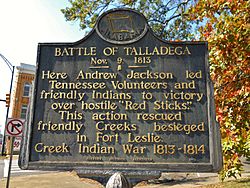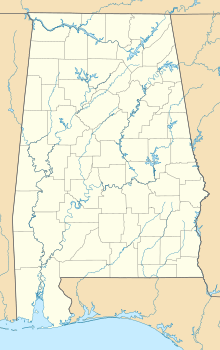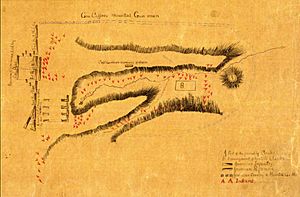Fort Leslie facts for kids
Quick facts for kids Fort Leslie |
|
|---|---|
| Talladega, Alabama in United States | |

Historical marker describing the Battle of Talladega
|
|
| Coordinates | 33°25′18″N 86°06′43″W / 33.42167°N 86.11194°W |
| Type | Stockade fort |
| Site information | |
| Owner | Private |
| Controlled by | Private |
| Open to the public |
No |
| Condition | Site on private land |
| Site history | |
| Built | 1813 |
| Built by | Alexander Leslie and allied Creeks |
| In use | 1813-1814 |
| Battles/wars | Battle of Talladega, Creek War |
Fort Leslie was a simple fort built from logs in 1813. It was located in what is now Talladega County, Alabama. This fort was important during a conflict called the Creek War.
During the Creek War, many forts like Fort Leslie were built. Settlers and some Creek people built them. They needed protection from other hostile Creek groups. Fort Leslie played a key role in the Battle of Talladega. However, it was left empty soon after the war ended.
Contents
A Look Back at Fort Leslie's History
Why the Creek War Started
The Creek War began because different groups within the Creek tribe disagreed. Some Creeks, known as the "Red Sticks," were unhappy with their government. They also opposed the United States. Other Creeks, called "White Sticks," supported the United States.
These two Creek groups were fighting each other first. Then, the War of 1812 started. The United States worried the Red Sticks might join forces with Great Britain. When Red Sticks began attacking settlers, the United States joined the fight in 1813.
Many settlers and White Sticks built forts for safety. These forts protected them from Red Stick attacks.
Building Fort Leslie
Before the fort was built, a man named Alexander Leslie had a trading post there. He was a Métis person. A trading post is like a store where people trade goods. Leslie was a main trader for the nearby Creek town of Talladega.
His father, also named Alexander Leslie, was from Scotland. He worked for a famous Creek leader named Alexander McGillivray. When fighting with the Red Sticks began, a protective fort was built around Leslie's trading post. It was named after him.
Construction of the fort started in the fall of 1813. Friendly Creeks from Chinnabee's town and Talladega helped build it. The fort was likely square or rectangular. It was made from upright, split cedar logs.
A map drawn after the Battle of Talladega shows Fort Leslie as a circle. Inside the fort, a platform was built. This allowed people to fire over the walls for defense. The people in the fort got their water from a nearby place called Big Springs.
Fort Leslie's Role in the War
After the Creek War started, American settlers and allied Creeks gathered at Fort Leslie. They sought protection from Red Stick attacks. Many allied Creeks came from the nearby town of Talladega.
The exact number of people inside the fort varies. Some say there were about 160 people. Others suggest between 154 and 180 allied Creek warriors and their families. These numbers do not include any Americans who might have been there.
Between November 3 and November 7, Red Stick warriors surrounded Fort Leslie. They demanded that the Creeks inside join them. If not, they threatened to kill them and take their supplies. This "siege" meant the fort's people quickly ran out of food and water.
Between November 7 and November 9, someone from Fort Leslie managed to escape. They went to tell Andrew Jackson at Fort Strother about the siege. Some say the messenger was James Fife, a member of the Natchez tribe. Others say it was Selocta, the son of a local Creek chief.
There's a story that the messenger escaped by covering himself in a wild hog skin. This helped him sneak past the Red Sticks at night. However, an early historian named Thomas Simpson Woodward said this story was not true.
News of the attack reached Jackson around November 7 to 9. Jackson quickly left Fort Strother on November 9. He wanted to rescue the people trapped in Fort Leslie. Jackson's army was smaller than he hoped. This was because General James White did not send troops to help.
Jackson's force arrived at Fort Leslie later that day. They then fought the Battle of Talladega. Davy Crockett, a famous frontiersman who was there, said 1100 Red Sticks surrounded Fort Leslie. While the main battle happened outside, some American soldiers did take shelter inside the fort.
During the battle, between 300 to 600 allied Creeks and 18 Americans were killed. After another major battle, the Battle of Horseshoe Bend, Jackson sent captured Red Sticks to Fort Leslie. From there, they were moved to Huntsville.
What Happened After the War
In 1958, there were discussions about making Fort Leslie a national monument. This idea was brought up in the United States House of Representatives. However, nothing more happened with this plan.
The exact spot of Fort Leslie was found in 1986. This was possible thanks to an old map from 1832. The map was found in the National Archives and Records Administration.
Fort Leslie Today
Today, the original site of Fort Leslie is on private land. It is not marked with any signs. Even though the location has been confirmed, most of the old fort's remains are gone.
A street in Talladega, Alabama, is named Fort Lashley Avenue. It runs near where Fort Leslie once stood.
Images for kids






